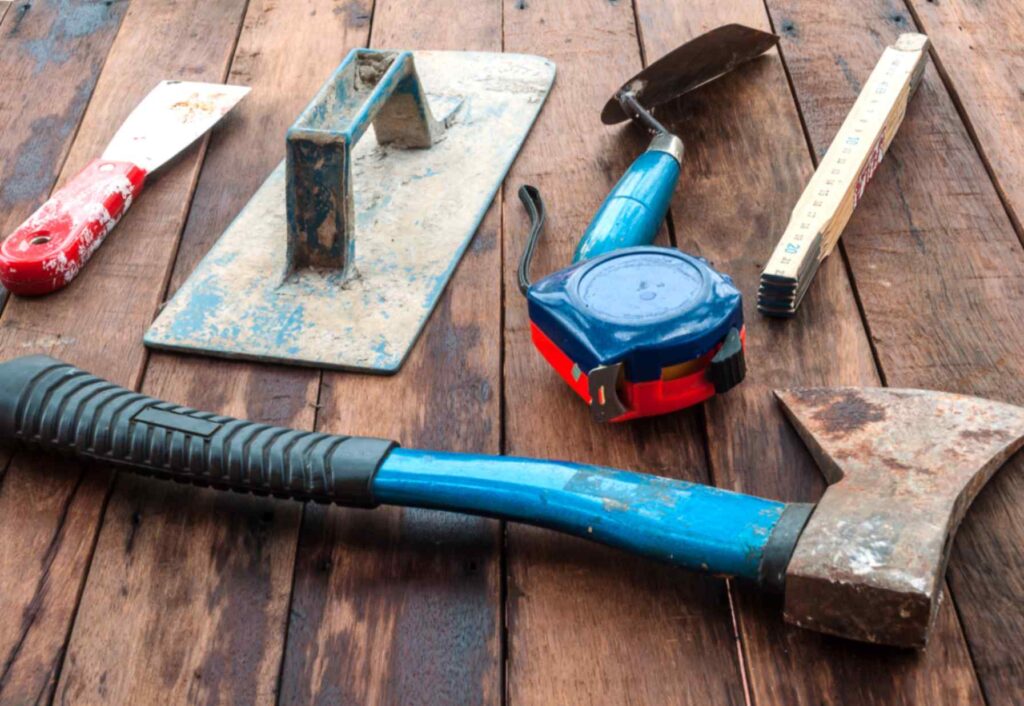
When you're working with concrete in Marietta, GA, understanding the tools and equipment contractors use can make a significant difference in the quality and efficiency of the job. From portable mixers that streamline the mixing process to advanced finishing tools that guarantee a smooth surface, each piece of equipment plays an essential role. You'll also find that safety gear is a non-negotiable aspect of this work. Curious about how these tools impact the overall project outcome and what the latest advancements are? Let's explore further.
Essential Mixing Equipment
When it comes to achieving the perfect concrete mix, having the right mixing equipment at your fingertips is vital. You'll want to choose the right mixer types based on your project size and specific needs. For small jobs, a portable concrete mixer can be a great choice, while larger projects may require a stationary mixer to handle bigger loads efficiently.
Understanding mixing ratios is equally significant. Proper ratios of cement, sand, aggregate, and water guarantee that your concrete has the desired strength and durability. A good rule of thumb is to follow a standard mix ratio, like 1:2:3 for cement, sand, and gravel, plus water as needed.
Using the right equipment not only helps you achieve these ratios but also guarantees consistency throughout the mixing process.
Don't forget to maintain your mixer regularly to prevent any issues that could affect your mix quality. Whether you're mixing on-site or in a more controlled environment, the right mixing equipment will save you time and effort, allowing you to focus on delivering an excellent concrete finish for your clients.
Pouring Tools and Techniques
After mixing your concrete to perfection, the next step is pouring it effectively. The right pouring methods can make all the difference in guaranteeing a smooth and durable surface. You'll want to choose a method that suits the size and type of your project, whether it's a small patio or a large foundation.
Start by preparing the area for concrete placement. Verify the forms are secure and the subgrade is compacted. For smaller jobs, you might use a wheelbarrow to transport the concrete from the mixer to the site. For larger projects, utilizing a concrete pump can save time and labor. This method allows for quicker placement and can reach difficult areas with ease.
When you're ready to pour, work in sections to maintain control over the flow of concrete. It's vital to avoid cold joints, so try to pour in a continuous manner.
As you pour, use a screed tool to level the concrete and guarantee even distribution. Remember, proper technique during the pouring phase sets the foundation for a successful finish, so take your time and focus on accuracy.
Finishing Tools for Concrete
Finishing concrete requires the right tools to achieve a smooth and professional surface. You'll want to start with various trowel types, including hand trowels and power trowels. Hand trowels are essential for smaller areas and detail work, while power trowels can cover larger surfaces quickly, saving you time and effort. Each trowel type has its purpose, so choose wisely based on your project needs.
Once you've selected your trowels, it's time to apply finishing techniques. Start by using a hand trowel to work the surface, smoothing out any imperfections. For larger areas, follow up with a power trowel to achieve a uniform finish. Remember to take into account the timing; finishing too early can leave marks, while finishing too late can result in a rough surface.
Don't forget about edging tools! They help create clean, sharp edges along the perimeter of your slab, enhancing the overall appearance.
Finally, for decorative finishes, you might explore additional tools like stamps or brooms. By utilizing the right finishing tools and techniques, you'll guarantee your concrete project looks polished and professional.
Curing and Sealing Equipment
When it comes to curing and sealing concrete, understanding the various methods and products available is vital for your success.
You'll want to compare different sealing products and learn the best application techniques to guarantee a durable finish.
Let's explore these essential aspects to help you achieve the best results in your concrete projects.
Curing Methods Overview
Curing methods are essential for ensuring the strength and durability of your concrete projects. By implementing effective curing strategies, you can enhance moisture retention, allowing your concrete to cure properly and achieve its full potential.
When you think about curing, it's important to remember that maintaining adequate moisture levels is vital during the initial curing period.
One popular curing method is the use of curing compounds. These compounds form a film on the surface, reducing evaporation and promoting moisture retention. You can also use wet burlap or plastic sheeting to cover the concrete, keeping it moist for an extended period. This method is especially beneficial in hot or windy conditions where evaporation rates are high.
Another effective strategy involves misting the surface with water. This technique helps maintain moisture levels without flooding the area. Remember, the goal is to keep the concrete moist for at least the first week after pouring.
Incorporating these curing methods into your projects will lead to stronger, more durable concrete. Ultimately, choosing the right curing strategy makes all the difference in enhancing the longevity and performance of your concrete work.
Sealing Products Comparison
After guaranteeing proper curing, the next step is to protect your concrete with the right sealing products. Choosing the right sealant can greatly impact the longevity and appearance of your concrete surfaces.
There are several sealing products available, each with distinct sealing techniques that cater to different needs.
Acrylic sealers are popular for their ease of application and quick drying time, making them perfect for decorative concrete. However, they mightn't offer the same level of protection as epoxy or polyurethane sealers.
Epoxy sealers provide excellent product durability, ideal for high-traffic areas, but require more preparation and longer curing times. Polyurethane sealers strike a balance between durability and flexibility, making them suitable for various applications, including indoor and outdoor surfaces.
When comparing sealing products, consider factors like UV resistance, moisture protection, and anti-slip properties. Each product has its own advantages and limitations, so think about your specific project requirements.
Application Techniques Explained
To achieve the best results in applying curing and sealing products, it's vital to understand the proper techniques and equipment involved. Start by selecting the right application methods for your project. Common techniques include spraying, rolling, or brushing the sealant onto the concrete surface. Each method has its advantages, depending on the area size and the desired finish.
When using a sprayer, make sure it's calibrated for an even distribution of the product. A roller can be effective for smaller areas, allowing for better control and coverage, while a brush can help you reach corners and tight spots.
Remember, consistency in application is key to achieving a uniform finish. As you apply the curing compound, be mindful of the coating techniques you're using. Overlapping strokes can help avoid missed spots but be careful not to over-apply, which can lead to pooling.
Always follow the manufacturer's instructions regarding drying times and reapplication, as proper curing is essential for the longevity of the seal. By mastering these application methods and coating techniques, you'll guarantee a durable, high-quality finish for your concrete surfaces.
Safety Gear for Contractors
When working with concrete, safety gear isn't just an option; it's a necessity. You're often exposed to various hazards, from heavy machinery to sharp tools and the potential for slips and falls. Following safety regulations is vital, not only to protect yourself but also to guarantee a safe working environment for your team.
Start with a hard hat to shield your head from falling debris. Safety goggles are essential to protect your eyes from dust and splashes of wet concrete. You'll also want to wear ear protection, especially when operating loud machinery.
Steel-toed boots are a must, as they safeguard your feet from heavy equipment and sharp objects on the ground.
Don't forget gloves! They provide grip and protect your hands from chemicals and abrasions. Long-sleeved shirts and pants can help keep your skin safe from irritants and injuries.
Finally, consider a high-visibility vest if you're working in areas with moving vehicles. By investing in the right protective gear, you not only comply with safety regulations but also enhance your efficiency and peace of mind on the job site.
Advanced Technology in Concrete Work
Embracing advanced technology in concrete work can greatly enhance your efficiency and precision on the job. With the rise of robotic automation, you can streamline processes that once took hours, allowing you to focus on more critical tasks.
Robots can assist in tasks like mixing, pouring, and even finishing surfaces, reducing human error and speeding up project timelines.
Digital mapping is another innovation that's changing the landscape of concrete work. Utilizing advanced software and GPS technology, you can create detailed project plans that help you visualize the final outcome before you even start.
This tech allows you to identify potential issues, ensuring your project runs smoothly from the get-go.
By integrating these technologies, you'll not only improve your workflow but also enhance the quality of your work.
Real-time data collection allows for adjustments on the fly, ensuring that what you're building meets the highest standards.
Frequently Asked Questions
What Types of Concrete Mix Are Commonly Used by Contractors?
When you consider concrete mixes, you'll find contractors often use standard mixes, high-strength variations, and specialty blends. They adjust mix ratios and incorporate concrete additives to enhance properties like workability and durability for specific projects.
How Do Contractors Determine the Amount of Concrete Needed?
To determine the amount of concrete needed, you'll use concrete calculators and measurement techniques. By calculating the area and depth of your project, you can accurately estimate how much concrete you'll require for a successful job.
What Is the Average Cost of Concrete Work in Marietta, GA?
When considering concrete work in Marietta, GA, you'll find average pricing typically ranges from $100 to $150 per cubic yard, with labor costs adding around $30 to $50 per hour, depending on project complexity.
How Long Does It Take for Concrete to Cure Completely?
Concrete typically takes about 28 days to cure completely. During this curing process, the concrete gains strength and durability. You'll notice significant improvements in curing time within the first week, but patience is key.
Are There Eco-Friendly Options for Concrete Materials?
Yes, there're eco-friendly options for concrete materials. You can choose sustainable materials like recycled aggregates, which reduce waste and environmental impact, helping you create a greener construction project while maintaining durability and strength.
Conclusion
In Marietta, GA, having the right tools and equipment is essential for concrete contractors. From mixers to finishing tools and safety gear, each piece plays an important role in ensuring quality work and compliance with safety regulations. By investing in advanced technology, you can enhance efficiency and precision on the job. Whether you're tackling small repairs or large projects, being equipped with the best tools makes all the difference in achieving a polished, professional result.
